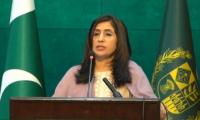It is not often that the government of the day in Pakistan can claim a high degree of consensus amongst independent economists who feel that the economy is doing better than it has over a longish period of time.
Since 2007, this is possibly the first time that a wide variety of individuals and institutions feel that Pakistan’s economy has been showing stable trends and is in the broad range of leading to probably higher levels of sustained growth.
Note, however, that such statements and observations do not necessarily – or at all – imply that the government’s finance and economic teams are responsible for the improved state of the economy. Extraneous sources and reasons might be more at play than improved management and so-called ‘home grown’ policies.
The terms doing ‘well’ or ‘better’ need to be applied with a great deal of caution and also need to be examined in their historical context. Clearly, a growth rate of somewhere in the region of four percent per annum for the economy is not a ‘good’ GDP growth rate, and numerous other indicators are also still extremely poor. Hence, one cannot make the outlandish claim that somehow Pakistan’s economy is doing well. However, if one considers the nature of difference and contrast with the previous Zardari government, by all accounts, the economy seems far better and much more stable.
Almost all economic indicators in June 2013 were abysmal. The private sector had stopped investing, economic growth was at its lowest in a decade, inflation at its highest in Pakistan’s history – it was in double digits for 40 months under the two prime ministers of Zardari. The fiscal deficit had deteriorated, resource mobilisation had slowed and debt had risen. Foreign exchange reserves were low, as was domestic and foreign sentiment and expectations about the economy.
The energy crisis was making matters worse and it was clear that the many individuals who were rotating as finance minister or governor of the central bank, were making matters more unstable rather than assuring investors, consumers and citizens. By all accounts, the economy performed particularly poorly under the Zardari leadership, but once again it is also important to point out that, while maladministration played an important part in this, numerous negative extraneous factors were also responsible.
In fact, some of the factors which caused the economy to do so badly under Zardari are similar to, but the opposite of, those which allow the Nawaz Sharif government to claim that the economy is doing well, or better. Inflation under Zardari was excessively high not due to domestic reasons related to profligate monetary or fiscal policy, but because of the astronomical rise in oil prices.
The worldwide depression after 2008, as well as high global food prices, made matters far worse. Most importantly, the Zardari presidency was fighting to establish some semblance of civilian control over a wounded military following a decade of military dictatorship, something for which Zardari deserves, but does not receive, much credit. None of these reasons are related to poor economic management which, however, made a bad situation far worse.
Just as much as the Zardari governments were unlucky facing steep obstacles and a hostile economic and political environment, the Nawaz Sharif government has faced an international environment that has benefitted him and his team of economic managers. Even if the government had done absolutely nothing, the fall in food and especially oil prices would have helped improve the economy – which they have. Moreover, even though the civilian-military balance kept shifting since 2014, the political situation in 2016 is nowhere near as precarious as it was between 2008 and the elections of 2013. Hence, over the last three years, almost every economic indicator is far better than it was between 2008 and 2013, a fact conceded to by even those who do not support the incumbent government.
So the economy has stabilised and is not in free-fall or in the range of high uncertainty as it was under the last government. One cannot ignore the fact that this has also been on account of the IMF playing a strong role in Pakistan’s economy, ensuring stabilisation. It is also due to rising remittances which have had a positive effect on real incomes and, as research shows, have played a major role in decreasing poverty.
The government’s income inequality figures, quite surprisingly, also show an improvement. Once again, one must make cautious and considered claims and not state that the economy has dramatically improved or is set for takeoff, just that it is better than it was in the previous decade.
After three years of an IMF stabilisation package, what next? It seems very likely that the government will not go for another IMF programme once the current one matures, and will wait till (if) it is re-elected in 2018. The reason for this is quite clear. The IMF programme which has played a key role in bringing about stabilisation, along with low oil prices and higher remittances, restricts growth and is an anti-growth programme. After three years of stabilisation, the government needs higher growth in order to address perennial issues of job creation, investment, social sector improvement and infrastructure development. And also to win votes.
The election cycle, or the political business cycle, will begin in full swing just as the IMF programme ends. With the intention of being re-elected, one can be sure that for the next two years, unencumbered by an IMF straightjacket, the PML-N governments, as well as the other provincial governments, are going to go into a spending spree. It will only be in 2018, after the elections, when the IMF will be invited back for another round of stabilisation.
While political-economic spending is going to be one plank of the government’s economic policy for the next two years, the other is going to be an as-yet ambiguous ‘game changer’ called the CPEC. Even a year after signing numerous agreements and with some projects already underway, there is still little openness and transparency and clarity about what China is going to do to Pakistan.
Other than the figure of $46 billion being floated around, there is much that is still obscure about all that has been promised and is anticipated. If the CPEC is the government’s sole long-term growth strategy, there is much to be concerned about. Chinese priorities, objectives and circumstances may change over the next few years, and then what?
It is time, and an opportunity, for the finance and economic managers of this government to show far greater resolve and initiative in thinking about and devising economic policies than simply relying on the Americans, the Chinese, the IMF or OPEC.
The writer is a political economist.
People stand in line up as election officials check their ballot papers during voting general election at a polling...
Women show their voter identity cards as they stand in a queue before casting their votes in Agartala. — PTIThe 18th...
Former prime minister Imran Khan. — Instagram/ imrankhan.ptiAn old saying has it that “when you dance with the...
Kashmiris in Indian illegally occupied Kashmir protesting against the Indian occupation as the forces of India looked...
A representational image showing residents walking at a wholesale market in Karachi. — AFP/FileOnce again there is...
A representational image showing late Pakistani human rights activist and Supreme Court lawyer Asma Jahangir. —...







